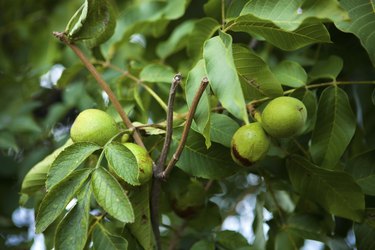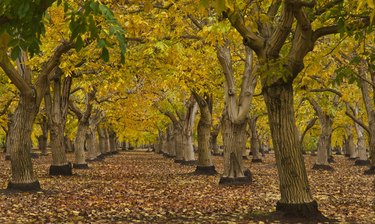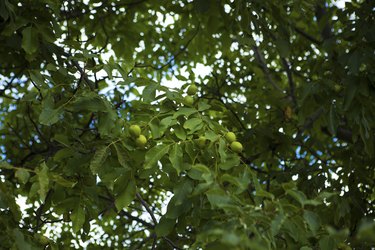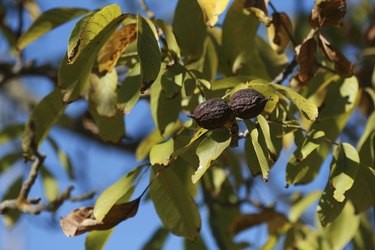
Walnut trees are a beautiful addition to any yard or orchard, but their size and vigor require yearly pruning. Following a few basic pruning guidelines, you can keep your walnut tree manageable, healthy and full of fruit.
Why Prune?
Video of the Day

Pruning walnut trees help shape and train them to grow in a desired pattern. Pruning removes weak or dead branches that either take away from the overall shape of the tree or would not be strong enough to support a heavy load of nuts. Pruning also invigorates the tree, allowing it to put more energy into fewer branches, improving its overall vigor and yield.
Video of the Day
When to Prune

When first planting a walnut tree, prune the top third of the tree back to a strong dormant bud. This bud will become the main growing shoot, creating a single trunk (or leader). For the first two to three years, allow the main leader to grow upward to form a central trunk. Choose the strongest branches growing from the central leader to form the tree's scaffold branches. After three years, the central leader and scaffold branches should be developed, giving the tree its form. To maintain a trees size and form, prune heavily every three to five years: shorten scaffold branches, remove upper-most growing tips, any crossing or weak side shoots and all dead/weak wood.
What Should be Removed

The main goal in pruning is to create a strong framework of branches growing off of the trunk. Remove any branches or suckers growing close to the ground, along with any weak or dead wood. Remove any branches growing at a low angle off the trunk (perpendicular) and any drooping limbs that might break under a heavy load. Trim and thin out some of the vertical shoots on the top of the tree to force growth downward for easier harvest next year.
How to Properly Prune

It is best to prune branches when they are small so the cut and wound size is minimized. When removing larger side shoots, the cut should be made leaving the "branch collar," or base of the removed limb. The branch collar is the part of the tree that will scab over, sealing the wound from insects and diseases. Never prune a side limb flush with the trunk. When pruning the top of the tree and branch tips, cut back to a strong dormant bud, leaving 1/2 inch above the bud for any possible die-back.
Other Considerations

Experts advise sealing large pruning wounds with horticultural wound paste. Simply brush on a thin layer of wound paste to seal the wound and protect the tree from pests and diseases. The tree will be protected until it can seal the wound itself.